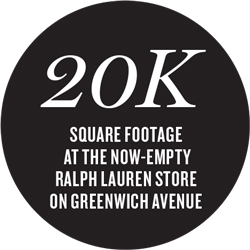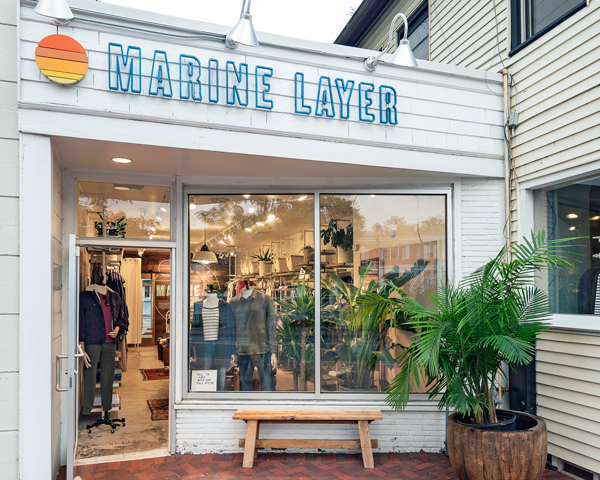As the retail reckoning continues, Fairfield County’s luxury shopping corridors are pitted against each other in an ever-intensifying battle to win tenants. Greenwich’s high-end strip seems to be beating out Westport’s — but that’s only because of falling rents in the former — and both markets are bracing for competition from GGP’s new upscale mall in Norwalk.
“Westport is certainly a market that has taken its hits,” said Jason Wuchiski, executive vice president and partner at RHYS. “A lot of these brands are saying, ‘Do we really need to be in Westport? If we’re going to do something, let’s just do Greenwich because the rents have come down.’”
And those rents have come down significantly, Wuchiski said. “Years ago, you’re looking at getting down to Greenwich Avenue at $140, $150 bucks a foot. Now we’re seeing deals being done at under $100.”
The new Greenwich Ave.?
Earlier this year, Ralph Lauren and Michael Kors both shuttered their stores on Greenwich Avenue, causing hand-wringing among brokers and landlords in the area.
Broker Taryn Talmadge of RKF is looking for about $120 per square foot on the ground floor and $40 a square foot on the upper level for the sublease of the 20,000-square-foot Ralph Lauren space, through 2024. There’s potential for Ralph Lauren to subsidize the right tenant, she suggested.
As those heavy-hitting brands vacate, depressing asking rents, they’re making room for retailers who would otherwise have been iced out of the exclusive corridor. It’s hard to beat the appeal of a location near stores like Baccarat, Intermix and Saks Fifth Avenue, brokers said.
For example, Bonobos, the menswear e-tailer, opened one of its 47 brick-and-mortar locations on Greenwich Avenue in spring 2017. The space was likely priced around the mid- to low-$90s per square foot, brokers estimated.
Bonobos said it was the area’s shopper profile that drew the brand in. “Greenwich made a lot of sense for us just because we were seeing a large amount of customers actually purchasing from the Greenwich area,” said Erin Grant, the senior manager of public relations for the New York City-based company.
 However, the possibility that rent in the area could go lower still is causing some potential tenants to play the waiting game in the expectation of getting a better deal down the line. “A lot of these retailers are definitely taking their time and being much more selective with some of their decisions here on the avenue,” Wuchiski said. “They’re willing to wait to get the rent to come down more so they don’t have any issues in the future.”
However, the possibility that rent in the area could go lower still is causing some potential tenants to play the waiting game in the expectation of getting a better deal down the line. “A lot of these retailers are definitely taking their time and being much more selective with some of their decisions here on the avenue,” Wuchiski said. “They’re willing to wait to get the rent to come down more so they don’t have any issues in the future.”
But not all Greenwich Avenue spaces are going at rock-bottom prices. Rag & Bone paid a premium rate when it moved its Greenwich shop to a new location on Greenwich Avenue in early 2017, broker Tom Torelli of Allied Property Group said. Rag & Bone reportedly paid $150 per square foot on an approximately 1,800-square-foot space. And Lululemon and Baccarat recently re-signed their leases at similar price points.
“[Rag & Bone] signed their lease at a high price,” Torelli said. “Where we’ve seen a change is tenants are still willing to pay a high price for the prime stores on the prime blocks, but the prices have come down on stores that are on secondary blocks or have any kind of configuration that’s not ideal.”
Several doors away from what was the Ralph Lauren store, Allied Property is asking for $135 per square foot at the former Michael Kors address.
Team Westport
There are instances in which downtown Westport’s Bedford Square retail center — which features a three-floor Anthropologie and lifestyle brand Serena + Lily — wins out over Greenwich.
“The real question for us was trying to decide if Greenwich or Westport was a better fit, as we liked both markets,” said Mike Natenshon, co-founder of California-based clothing brand Marine Layer, which opened in Westport in June 2017. “Ultimately, we felt like Westport was a bit more vibrant and there were some more interesting concepts opening up alongside of us.”
Natenshon’s preference speaks to a significant distinction between the two luxury corridors — their size and the resulting difference in the kinds of tenants they attract.
“Greenwich is a city of close to 60,000, Westport is a town of more like 27,000,” said David Waldman, president and founder of David Adam Realty, a Westport firm that was one of the developers of Bedford Square. “So while they compete in terms of the quality of the type of tenant they’ve gotten, Greenwich is far bigger, has a bigger draw and they’ve been able to bring in the Guccis and the higher-end brands,” he said.
Norwalk’s big bet
But the biggest and baddest competition for luxury tenants may come in the form of the unlikeliest of adversaries: a new mall. Some worry that GGP’s SoNo Collection, an in-development shopping center set to open in Norwalk in 2019, will draw tenants away from both Westport and Greenwich.
The construction of the new mall is a bit confounding to some in the industry, given reports from across the country about malls hemorrhaging tenants and even transforming into Amazon fulfillment centers in some instances. The Wall Street Journal even posited that the SoNo Collection could be the last American mall ever built.
But the project has confirmed Nordstrom and Bloomingdale’s as anchor tenants — and the mall will be the only Connecticut location for both brands — which has some retail landlords shaking in their boots. “That’s muddying the waters a little bit in that category,” Wuchiski said of the mall’s potential lock on luxury tenants. “Nobody really knows what that’s going to look like.”
However, the smaller scale of the shopping corridors of Greenwich and Westport may have a leg up when it comes to where shopping habits are trending.
“Yes, they’ll still use Amazon for toilet paper and paper towels and things like that, but as far as clothes and discretionary spending and soft goods, we’re seeing that there’s a little bit of a pushback to come to the downtown central business district as opposed to the internet or the big-box retailer,” explained Jonathan Gordon, a broker and the CEO of Admiral Real Estate Services in Bronxville. “It’s too early to call it a trend, but it’s more of a feeling that there may be a little bit of a backlash.”
Industry experts agreed that for brands with a large e-commerce presence, a brick-and-mortar location has to offer something the online experience can’t, such as nearby dining.
“That’s what towns have always tried to do by incorporating food and nightlife and things like that into their retail centers,” David Adam Realty’s Waldman said. “It’s what I’ve always thought was a key component of all developments, which is creating some sort of sense of place so you can distinguish yourself.”
